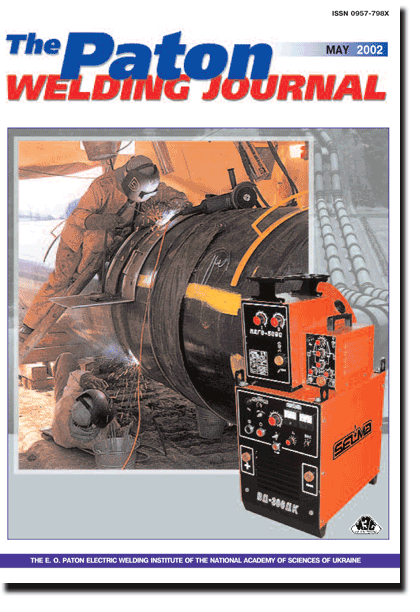

| SCIENTIFIC AND TECHNICAL | |
|
Makhnenko V.I., Barvinko A.Yu., Barvinko Yu.P. and Tsiarkovsky P.
Estimation of stressed state of the wall of coiled vertical cylindrical tanks in welding-in of insert plates. | 2 |
| Given are the results of calculation of stressed state of the wall of a coiled tank with a capacity of 50,000 m3 in welding-in of insert plates. Theoretical estimation of the possibility of loss of stability of the wall due to the effect of residual welding stresses is presented. It is shown that the welding technology recommended by standards fails to provide retention of the designed geometrical shape of the wall in the case of replacement of its vertical assembly welded joints arranged in line by joints with the welds separated in chords. | |
|
Shvachko V.I. and Stepanyuk S.N.
Peculiarities of cold cracking in welding of high-strength low-alloy steels. | 7 |
| Peculiarities of cold cracking of high-strength low-alloy steels are considered using a physical model. It is shown that their structure becomes highly sensitive to the embrittling effect of hydrogen under the influence of high temperature, losing the positive effect of thermomechanical treatment, and thus, becomes more susceptible to cold cracking. | |
|
Markashova L.I., Arsenyuk V.V. and Grigorenko G.M.
Peculiarities of plastic deformation of dissimilar materials in pressure joining. | 9 |
| Considered are regularities occurring in physical-chemical processes of plastic deformation, mass transfer and phase formation, which accompany formation of joints in dissimilar materials (copper, titanium, aluminium and their alloys, and different grades of steels) characterised by a limited mutual solubility under conditions of pressure joining for a wide range of external loading rates, i.e. from 1x10-4 to 1x104-1x105 s-1. | |
|
Tsybulkin G.A.
To the question of GMAW stability. | 14 |
| The detailed analysis of transient and steady processes in welding circuit, as a result of which the region of stationary conditions and limits of their asymptotic stability were defined is presented. | |
| Lugovoj Z.P. and Nesterenko N.P.
Energy dosing in ultrasonic welding of rigid polymers. | 16 |
| Specific features of technology of ultrasonic welding of rigid polymers on the example of products made from polymethylmethacrylate are described. Mathematical model of thermomechanical processes realized in the zone of welding was suggested and the main stages of polymer vibroheating were analyzed. Criterion of automatic dosing of applied energy, based on the dependence of deformation and temperature of weld zone on the amplitude of wave guide oscillations has been developed. | |
| Yukhimenko R.V.
Methods of design of welding inductors (Review). | 19 |
| The most widely used methods for design of welding inductors are considered. Advantages and drawbacks of the described methods and also the feasibility of their use in practice are outlined. Main relationships of parameters of experimental and claculated data of a linear inductor for heating flat surfaces and for seam induction welding are given. | |
| INDUSTRIAL | |
| Paton B.E., Korotynsky A.E., Skopyuk M.I., Yumatova V.I., Kopilenko E.A., Pavlenko G.V., Pavlenko G.L. and Chmykhov N.V.
System of in-process quality control of welding equipment during its manufacturing. | 25 |
| In view of the increasing number and diversity of the types of welding equipment and higher requirements to its quality, practical implementation of the requirements of GOST 25616-83 in production testing involves a considerable material consumption and time. A variant of forecasting the technological properties of welding equipment is proposed, which is based on the results of electric testing, using a variable resistive load. Various variants of applying the hardware, program and algorithmic elements of the systems of in-process control of welding equipment parameters are considered. | |
| Sidoruk V.S. and Galinich V.I.
Classification of arc welding fluxes by the method of their application, manufacture, composition and type of metal being welded. | 28 |
| A classification of welding fluxes by various features is proposed. It is suggested that the number of classification parameters is increased, compared to the existing ones, namely from 1 to 12 by the application method, from 3 to 7 by the manufacturing method, from 10 to 18 by composition, and up to 26 taking into account the forecast slag compositions, etc. | |
| Pentegov I.V., Rymar S.V., Lavrenyuk A.V. and Petrienko O.I.
Welding three-phase transformers with improved technical-economical characteristics. | 33 |
| New designs of three-phase welding transformers with tape multicore magnetic circuits are considered. As compared with traditional transformers, they have improved technical-economical characteristics and can be competitive at the market of welding equipment. | |
| Vasilkov V.I., Kislitsky A.A., Onuchin N.V., Rozhkov V.V., Strukov A.V., Chizhov V.B. and Lavrenyuk P.I.
On the causes for formation of defects in welds of E110 alloy made by electron beam welding and methods of controlling them. | 36 |
| The paper deals with the possible causes for initiation of outer and inner defects in EBW of fuel elements to fuel cladding of E110 alloy. It is shown that the sources of pores in welds are gaseous products of sublimation of organic and inorganic materials in microvolumes between the surfaces being welded. Recommendations are given on prevention of pores and undercuts in welds. | |
| Boroznyak A.I.
Electrohydropulse permanent joining of hollow pieces using exploding elements. | 39 |
| Investigations were conducted with electrohydropulse pressing of tubes into tube sheets with different configurations of channels. Dependencies of the degree of filling of die cavities upon the shape of cross sections of exploding elements were established. Device for pressing tubes into tube sheets was developed. | |
| Karasev M.V., Kopilenko E.A., Pavlenko G.V., Rabotinsky D.N., Soroka V.L., Solyanik V.V. and Karasev E.V.
Main tendencies of development of welding equipment manufacture in "SELMA-ITS" Association and its application in Russia and CIS countries. | 41 |
| Comparison of technical-economic characteristics of equipment applied in Russia and CIS is made, taking into account the world market of welding equipment. Characteristic directions of welding equipment improvement are outlined. Recommendations are given on its selection during performance of specific work. | |
| BRIEF INFORMATION | |
| Royanov V.A. and Psaras G.G.
Control of penetration depth in surfacing of copper tracks. | 46 |
| Decrease in energy input of surfacing and reduction in depth of penetration leads to the decrease in the amount of deposited metal. In this case to produce the preset section of bead it is necessary to use the multipass surfacing. Surfacing in several layers of copper alloys is accompanied by the formation of pores, cracks, metal leak-in and other defects [1, 2]. | |
| Shatrava A.P.
Physical-mechanical characteristics of steel-bronze coatings produced using laser surfacing. | 48 |
| Physical-mechanical characteristics of composite coatings produced using a laser surfacing were studied. Dependencies of service characteristics of working surfaces on structural-phase composition of deposited layers were established. Mechanism of improving wear-resistance of a friction pair was developed. | |
(You are viewing the simplified file contents)
The cost of subscription/purchase order journals or individual articles
| Journal/Currency | Annual Set | 1 issue printed |
1 issue |
one article |
| TPWJ/USD | 384 $ | 32 $ | 26 $ | 13 $ |
| TPWJ/EUR | 348 € | 29 € | 24 € | 12 € |
| TPWJ/UAH | 7200 UAH | 600 UAH | 600 UAH | 280 UAH |
| AS/UAH | 1800 UAH | 300 UAH | 300 UAH | 150 UAH |
| AS/USD | 192 $ | 32 $ | 26 $ | 13 $ |
| AS/EUR | 180 € | 30 € | 25 € | 12 € |
| SEM/UAH | 1200 UAH | 300 UAH | 300 UAH | 150 UAH |
| SEM/USD | 128 $ | 32 $ | 26 $ | 13 $ |
| SEM/EUR | 120 € | 30 € | 25 € | 12 € |
| TDNK/UAH | 1200 UAH | 300 UAH | 300 UAH | 150 UAH |
| TDNK/USD | 128 $ | 32 $ | 26 $ | 13 $ |
| TDNK/EUR | 120 € | 30 € | 25 € | 15 € |
AS = «Automatic Welding» - 6 issues per year;
TPWJ = «PATON WELDING JOURNAL» - 12 issues per year;
SEM = «Electrometallurgy Today» - 4 issues per year;
TDNK = «Technical Diagnostics and Non-Destructive Testing» - 4 issues per year.


